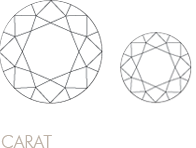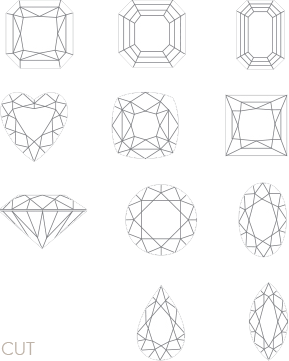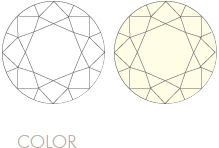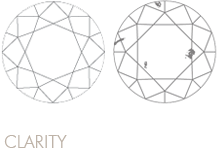 THE FOUR “C’s”
THE FOUR “C’s”
Become a jewelry expert with this professional guide to selecting the perfect Diamonds and Colored Gems!
Selecting diamonds and gemstone can be difficult without proper knowledge. We at Tufenkjian want you to enjoy
choosing your jewels from us by becoming an expert in the art of assessing the quality of your investment.
Each gem is a crystallized mineral varying in color, hardness and optical properties. Accurately determining the
quality involves what jewelers refer to as the four “C’s.” These are known as Color, Clarity, Cut and Carat Weight.
Additionally, some jewelers use a 5th “C,” Color Clarity, to assess the value of a colored gem.
Selecting diamonds and gemstone can be difficult without proper knowledge. We at Tufenkjian want you to enjoy
choosing your jewels from us by becoming an expert in the art of assessing the quality of your investment.
Each gem is a crystallized mineral varying in color, hardness and optical properties. Accurately determining the
quality involves what jewelers refer to as the four “C’s.” These are known as Color, Clarity, Cut and Carat Weight.
Additionally, some jewelers use a 5th “C,” Color Clarity, to assess the value of a colored gem.

Wt2 x C = price per stone.

- Shape (round, oval, square, emerald, trillion etc.)
- Cutting style (i.e. facet pattern)
- Proportion (of crown and pavilion)
- Symmetry
- Finishing

The most precious of all gems, the diamond is typically colorless or possesses a very light tinting of yellow or brown. Diamonds are rated from D to Z, D being colorless or exceptionally white and of the highest value. A diamond’s value decreases as it becomes more tinted and is classified white, slightly tinted white, tinted white and tinted color.
Colored gems:
For any gem other than a diamond (e.g. emerald, ruby, sapphire etc.), color is the most important factor in determining quality. A superior quality gemstone ranks highest in all three dimensions of color - Hue position, Saturation and Tone.
Hue position is the position of a color (excluding white and black) on the color spectrum, of which red, blue and green are the most desired.
Saturation refers to color intensity or the deepness of a color; and typically, the more highly saturated a gemstone is, the more value it carries.
Tone is the degree of lightness or darkness of a color as determined by amount of light absorption: white being 0% and black being 100% in absorption. Though tone preference is based on individual opinion, it is professionally advised to select gems that look good even under low lighting conditions.

Clarity is generally graded from Loupe Clean (LC) or Flawless(FL), through VVS1 (Very, Very Slightly Included) and VVS2; to VS1 and VS2 (Very Slightly Included); SI1 (Slightly Included) and SI2 to P1 (Piqué) and P2; and finally, I1 and I2 (Included).
Though the appearance of less inclusions typically increases value, some colored gems are considered more beautiful and value due to their inclusions.
